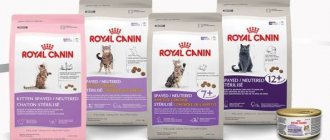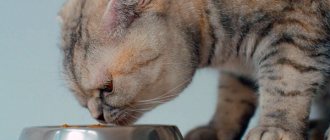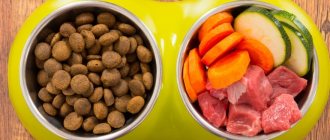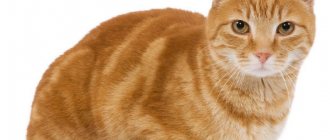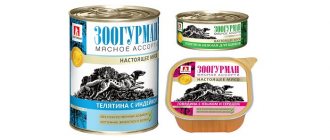What does the daily norm depend on?
The daily feed intake is calculated taking into account the following characteristics:
- age;
- weight (normal, underweight or overweight);
- the amount of physical activity during the day;
- tendency to obesity.
These 4 factors are the key ones; it is from them that you need to start each time when calculating.
Don't rely on the charts on any food package. The dosages in them are very often overestimated, and in addition, when compiling them, manufacturers do not take into account all the necessary indicators.
In addition to these mandatory points that affect the calculation of the daily allowance, it is worth paying attention to purely individual aspects. These include:
- pregnancy;
- living conditions (in the house or on the street);
- growth rate (depending on the breed);
- recovery period after illness.
If the dog doesn't eat enough
You can tell that an animal is hungry by its licked bowl and condition. Lethargy and low activity indicate a lack of nutrients. Solutions may vary:
- familiarize yourself with the manufacturer’s recommended dosage and strictly follow the instructions on the packaging;
- change food brand;
- review the feeding schedule and adequately assess the dog’s activity.
If the advice does not help, it is better to contact a veterinarian. The cause of hunger can be helminths and gastrointestinal diseases.
Proper feeding is the key to your pet’s health. You should carefully consider the choice of product brand, its composition and calorie content. Nutrition dosage is a flexible indicator that is adjusted depending on the dog’s condition, its activity, age, and body weight.
Feed class and energy value
The classification identifies three types of feed. They differ from each other in composition, quality properties, calorie content and balance.
So that you can choose the right food and include it in your dog’s diet with peace of mind, we suggest you carefully study each class.
Superpremium
This category includes the best dog food. They are distinguished by their special balance and high percentage of meat components. They contain no soy and minimal amounts of corn are added.
Therefore, you can give super premium food to your pet constantly. You don’t even need to buy additional vitamin supplements, since the finished granules contain all the necessary elements in full. The energy value of such a product is 360-450 kcal.
Premium
Food of this class is somewhat worse than the previous one. It also has a meat component, but its share is small - only 20%. In addition to animal proteins, the composition includes grains and corn in fairly large quantities. Minerals along with vitamins are present in sufficient quantities. Premium calorie content is 300-350 kcal.
Economy
The cheapest and lowest quality food. Its composition is poor. The feed mixture mainly consists of grain crops and corn.
The lack of meat is compensated by the presence of soy. This type of dog food is not nutritious (calories vary between 250-300 kcal) and not healthy.
To ensure that the animal still receives all the elements necessary for its life, add additional mineral and vitamin supplements to the pet’s menu.
Ready-made feed
The composition of industrial feeds is already balanced. This diet is enriched with vitamin and mineral supplements necessary for the development of the kitten. There are dry and wet food. When feeding, it is better to give preference to one type of food. If you still decide to use both dry and wet food, then separate them and feed them at different meals.
Advantages of ready-made feed:
- Convenience. Such food saves time that would have to be spent on cooking.
- The feed is already balanced.
- When eating dry food, the kitten actively works with its jaws, which puts the necessary load on the entire oral apparatus. This stimulation promotes proper development of the jaw muscles and bones.
- Among the ready-made foods there is a large selection of lines according to the tastes and physiological state of the pet.
Disadvantages of ready-made feeds:
- High quality feed has a high cost.
- It is difficult to choose food among a large number of different brands.
- Dependence on economy-class flavor enhancers is developing.
Rules for feeding a 3 month old kitten dry food:
- Feed should be given in accordance with the norm indicated on the package.
- The food must correspond to the type of animal, its age and physiological condition.
- It is better to feed the same brand and line of food.
- When feeding dry food, clean water should be nearby.
- Food should not sit in a bowl; such food becomes of poor quality.
Acana
Canadian-made food belongs to the super-premium class. The composition is good, does not contain cereals. Fresh (8%) and raw (8%) meat, fresh whole eggs (8%), as well as dehydrated poultry (8%), and offal are used as a source of protein. The total amount of protein products is 35%. There are useful ingredients such as: apple, pear, cranberry, brown algae, carrots, pumpkin and others.
Only dry food with fish, lamb and chicken flavors is available for sale.
The feeding rate for kittens 5-20 weeks is 60 grams per kg of weight.
Royal Canin
Premium food. The protein content in wet food is 10-12%, and in dry food 36%. The protein in this food is mainly vegetable. Excess amount of carbohydrates. There are also corn flour, dry beet pulp, and soybean components.
This brand of food contains mainly poultry meat. Royal Canin brand food is presented in the form of canned pates, wet and dry ready-made food.
For babies aged three months, you should choose Royal Canin MOTHER&BABYCAT food - this food is perfect for feeding kittens from 1 to 4 months. For a four-month-old kitten, Royal Canin Kitten food is suitable. This food can be fed to kittens from 4 to 12 months.
During the day, the baby will need 50-65 g and 55-70 g, respectively.
Bosch Sanabelle Kitten
This food belongs to the same class as Royal Canin. The composition contains all the necessary components. Fresh poultry meat – 25%, fresh liver – 5%. The composition is enriched with fiber, eggs, animal fats, calcium supplements and brewer's yeast. Also in the list of ingredients there are those that can cause allergies - these are maize and cellulose.
Kittens can eat this food for up to a year, and it is also suitable for pregnant and lactating cats. You can choose either dry food or wet food.
The feeding rate is 55-60 g and 60-65 g, respectively.
Number of feedings and volume of portions depending on age
A young and an adult animal needs different amounts of energy consumed. It is logical that the number of approaches to the bowl and the portions themselves will not match between two generations. Now we will try to find out how much dry food a dog should be given per day, based only on its age.
For adult dogs
A pet that has reached the age of one is considered an adult. From this point on, he must be slowly transferred to two meals a day.
And since you will have to feed the dog less than usual, the question will arise about creating the correct portion size so as not to overfeed the dog, but also not to leave him hungry.
| Daily value for an adult dog | |
| Feed class | Volume of one serving (g) |
| Superpremium | 300-400 |
| Premium | 500 |
| Economy | 700 |
For puppies
Puppies eat more often than adult dogs, but as they grow older, the number of meals decreases, but the portions, on the contrary, become larger. We offer you a detailed table that shows how many times a day to feed a puppy from 1 month to a year and a half.
| Age | Quantity | Single serving (g) |
| 1-2 months | 7 | 100-200 |
| 2-3 months | 6 | 150-200 |
| 3-4 months | 5 | 250-450 |
| 4-8 months | 4 | 500-800 |
| 8-1 years | 2-3 | 800-1200 |
| Over 1.5 years | 2 | 1500-2000 |
For pregnant and lactating women
To ensure that pregnant and lactating dogs, and with them puppies, receive everything they need for full functioning, change their diet. From the 5th week of gestation, gradually increase (and so on every 7 days) the amount of the daily norm. By week 9, the daily amount of food should be 1/3 more than usual.
After giving birth, in the first 3 weeks, the new mother must eat intensively, so feed her three times a day.
Starting from 4 weeks, feeding is increased to 4 times a day. Serving sizes will also vary:
Week No. 1 – 150% of the usual serving volume.
Week No. 2 – 200% of normal.
Week No. 3 – 300% of the usual size.
Adjustment of the norm
Let us remind you that you should pour food into a bowl once or twice a day strictly according to the norm and monitor how quickly the food runs out and whether the kitten shows signs of hunger. If you decide to give out food twice, do not forget to divide the daily amount into two parts.
When calculating the norm, you should also take into account the additional nutrition that the kitten receives - most often, these are various treats. They should make up no more than 10% of the total food volume.
Carefully monitor how much food your pet eats per day, because in the first year of a kitten’s life you will have to adjust feeding rates quite often due to the animal’s growth.
If the kitten has normal body condition and weight, then everything is fine and there is no need to adjust the norm. In all other cases, it is necessary to increase or decrease the norm, since underfeeding and overfeeding a baby can affect the health and longevity of an adult animal.
How to do the calculation yourself
There is nothing difficult about this if you know the correct calculation scheme. You can calculate the amount of daily servings using a simple scheme: divide your pet’s daily calorie needs by the energy value of the food.
We wrote about the calorie content of dry food in the article above. We bring to your attention now a table with indicators of the energy that a particular dog spends daily.
How to feed a kitten
At this age, the kitten should eat the same type. This means that you need to stick to feeding either natural food or ready-made food. When moving to a new home, the baby should be kept on his usual diet. When a new owner decides to transfer his four-legged friend to a different type of food, he should start doing this gradually, after a month. This is due to the fact that the kitten needs some time to adapt to new conditions. Next, we’ll look at what to feed a 3-month-old kitten.
Don't forget about the drinking regime. Make sure your kitten always has access to water. When feeding natural food and wet prepared foods, the body's need for water is not high. If you feed your pet mostly dry food, then he needs 2 or even 4 times more water.
Feeding dry food depending on the size of the pet
Obviously, the amount of dry food for dogs of large and small breeds is different. It will not be difficult to calculate how much your pet will need. Select your dog's weight and read the approximate calculation.
For small breeds
The daily norm for adult small breeds (weighing up to 15 kg) is 300-400 g of food if we are talking about economy class, and 150-300 g if you give your pet premium.
An animal weighing 15-35 kg should consume 400-600 g of low-grade food or 300-400 g of a premium product.
For large breeds
These include dogs weighing 35-65 kg. Large breed animals need to be fed with plenty of food. Give them either 400-600 g of premium food or 600-800 g of economy food.
For your maximum convenience, we provide above a detailed table that clearly and clearly outlines how much dry food to give your dog per day.
Calculation of dog food for 1 serving
Knowing the daily volume of food, it is not difficult to calculate the amount of granulated food served in one feeding.
How to determine the mass of a serving
How to calculate the amount of food for a dog: you need to divide the daily amount by the number of feedings; for adult animals this is two. The amount of food per 1 kg of body weight per day for an adult dog depends on the breed, weight and calorie content of the food (see above).
Active animals, service dogs or athletes need special consideration, as well as pregnant and lactating women. To the usual dosage of dry dog food, approximately 1/3 of the serving is added for working dogs and 1/4 for pregnant and lactating dogs. If the dog is elderly and inactive, the portion should be reduced by about 1/3.
How to measure the required weight
It’s definitely not possible to measure dry food without a scale. Therefore, if you want to know the perfectly accurate amount of feed, you will have to purchase a kitchen scale.
Manufacturers of some expensive foods include special measuring cups in the pack, with which you can pour the desired portion. However, it is worth remembering that such a container is designed only for this brand, because all dry products have granules of different densities, sizes and weights.
If you count only approximately, the food can be poured into a 100 ml cup - it will be about 240-250 grams. When buying food in bulk, you can ask the seller to divide the product into several parts equal to the daily feeding rate. And at home you can simply divide them in half: for breakfast and dinner.
How much water does a dog need per day?
To answer this question, we must remember: per 1 kg of an adult animal there is 40 ml of liquid (under normal, not extreme conditions). In puppies, this figure is 2-3 times higher, but as they grow older, the need for plenty of fluids will also decrease.
The size of the dog also affects how much water it needs. For example, the smaller the dog, the more thirsty he will be.
Planned physical activity is also a reason to take a bottle of fresh water with you in reserve.
Is it possible to soak the granules?
Definitely yes (and only with water), but there is no point in doing this if there is not a single indication. However, there are certain situations when it is worth making dry food wet. These include:
- dental problems;
- gastrointestinal surgery;
- some diseases of the digestive system;
- the first months of a puppy’s life;
- change of teeth;
- the animal prefers soaked food more than dry food.
In other cases, it makes no sense to soak the granules.
In any case, always consult a veterinarian about your pet, and its nutrition in particular. Reasonable care will ensure excellent health for your pet, and you will have peace of mind for it.

